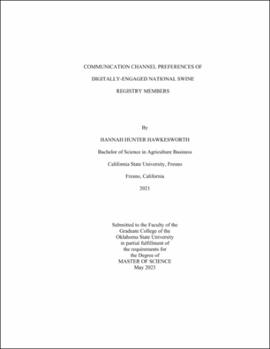| dc.contributor.advisor | Cartmell, D. Dwayne, II | |
| dc.contributor.author | Hawkesworth, Hannah Hunter | |
| dc.date.accessioned | 2023-08-25T20:06:05Z | |
| dc.date.available | 2023-08-25T20:06:05Z | |
| dc.date.issued | 2023-05 | |
| dc.identifier.uri | https://hdl.handle.net/11244/338920 | |
| dc.description.abstract | Understanding membership preferences for communication channels is important to the success of any breed association. Although research has studied beef breed associations, there is a lack of research focusing on swine breed associations and membership perceptions. The purpose of this study was to gauge digitally-engaged National Swine Registry members’ perspectives of the organization’s communication channels and provide the NSR more knowledge about its digitally-engaged members. Specifically, this study sought to determine members’ communication preferences, reasons for following digital media channels, and suggested enhancements for the organization’s current communication channels. A review of literature concluded livestock producers prefer print publications over social media as the primary form of communication from breed associations. The literature also indicated social media has the potential to be beneficial, and the most preferred platform for producers is Facebook. The Uses and Gratifications Theory undergirded this study. Dillman’s Tailored Design Method (2014) guided this study. The questionnaire combined 5-scale Likert-Type, demographic, and open-ended questions to achieve the research objectives. Due to the response rate, the findings from this study are only generalizable to the 85 respondents. Results noted digitally-engaged NSR members found the organization’s communication channels to be useful, appropriate, educational, informative, and engaging. This study aligned with many of the findings concluded from previous literature. The digitally-engaged members’ preferred Facebook as their primary communication channel. This finding contradicted previous research, which found social media to be the least preferred communication channel amongst producers. It is recommended the NSR conduct a digital media audit on all digital platforms and increase educational content across communication channels. Further research with swine breed associations and evaluating swine producers is recommended. Specifically, an evaluation of the remaining NSR communication channels, media platforms, as well as a qualitative study focusing on active members at shows is recommended. | |
| dc.format | application/pdf | |
| dc.language | en_US | |
| dc.rights | Copyright is held by the author who has granted the Oklahoma State University Library the non-exclusive right to share this material in its institutional repository. Contact Digital Library Services at lib-dls@okstate.edu or 405-744-9161 for the permission policy on the use, reproduction or distribution of this material. | |
| dc.title | Communication channel preferences of digitally-engaged national swine registry members | |
| dc.contributor.committeeMember | King, Audrey E. H. | |
| dc.contributor.committeeMember | Henley, Parker | |
| osu.filename | Hawkesworth_okstate_0664M_18202.pdf | |
| osu.accesstype | Open Access | |
| dc.type.genre | Thesis | |
| dc.type.material | Text | |
| dc.subject.keywords | breed association | |
| dc.subject.keywords | communication channel preferences | |
| dc.subject.keywords | digital media | |
| dc.subject.keywords | digitally-engaged | |
| dc.subject.keywords | swine industry | |
| thesis.degree.discipline | Agricultural Communications | |
| thesis.degree.grantor | Oklahoma State University | |
